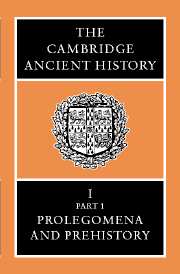Book contents
- Frontmatter
- Contents
- List of Maps
- List of Tables
- List of Text-figures
- Preface
- Chapter I The Geological Ages
- Chapter II Physical Conditions in Eastern Europe, Western Asia and Egypt Before the Period of Agricultural and Urban Settlement
- Chapter III Primitive Man in Egypt, Western Asia and Europe in Palaeolithic Times
- Chapter IV The Evidence of Language
- Chapter V The Earliest Populations of Man in Europe, Western Asia and Northern Africa
- Chapter VI Chronology
- Chapter VII (a) The Earliest Settlements in Western Asia from the Ninth to the End of the Fifth Millennium B.C.
- Chapter VII (b) Anatolia Before 4000 B.C.
- Chapter VIII The Development of Cities From Al-‘Ubaid to the End of Uruk 5
- Chapter IX (a) Predynastic Egypt
- Chapter IX (b) Palestine During the Neolithic and Chalcolithic Periods
- Chapter IX (c) Cyprus in the Neolithic and Chalcolithic Periods
- Chapter X The Stone Age in the Aegean
- Bibliographies
- Index to Maps
- General Index
- Maps
Chapter IX (b) - Palestine During the Neolithic and Chalcolithic Periods
Published online by Cambridge University Press: 28 March 2008
- Frontmatter
- Contents
- List of Maps
- List of Tables
- List of Text-figures
- Preface
- Chapter I The Geological Ages
- Chapter II Physical Conditions in Eastern Europe, Western Asia and Egypt Before the Period of Agricultural and Urban Settlement
- Chapter III Primitive Man in Egypt, Western Asia and Europe in Palaeolithic Times
- Chapter IV The Evidence of Language
- Chapter V The Earliest Populations of Man in Europe, Western Asia and Northern Africa
- Chapter VI Chronology
- Chapter VII (a) The Earliest Settlements in Western Asia from the Ninth to the End of the Fifth Millennium B.C.
- Chapter VII (b) Anatolia Before 4000 B.C.
- Chapter VIII The Development of Cities From Al-‘Ubaid to the End of Uruk 5
- Chapter IX (a) Predynastic Egypt
- Chapter IX (b) Palestine During the Neolithic and Chalcolithic Periods
- Chapter IX (c) Cyprus in the Neolithic and Chalcolithic Periods
- Chapter X The Stone Age in the Aegean
- Bibliographies
- Index to Maps
- General Index
- Maps
Summary
This title conforms with the conventional nomenclature of the archaeological periods, but it has become obvious how far such terms are inadequate—at least in relation to the Near East. In Palestine there was an initial phase of the Neolithic period in which pottery was not known, a fact which it is hard for European prehistorians to credit; in the ‘ Chalcolithic’ period metal was scarcely used and in the ‘Early Bronze’ age which followed only copper was yet known. It seems preferable to demarcate the different periods according to the successive stages of human development: (i) the first settlements (Neolithic without pottery) in which there was a transition from an economy of food-gathering (hunting and collecting) to an economy of production (breeding of livestock and agriculture), villages of hunters who were beginning to be shepherds and farmers; (2) villages of farmers and potters, who drew their main source of livelihood from the breeding of domestic animals and/or the cultivation of grain crops and who had a knowledge of pottery (Neolithic with pottery); (3) villages of farmers, potters and metalworkers, who were beginning to work in, and make use of, copper (Chalcolithic). A new era was to open with urban life and the first fortified cities (Early Bronze). These divisions are in themselves somewhat arbitrary: the adherence of groups of people to the soil had begun with the Mesolithic period; the advent of pottery is a convenient point for marking the transition to the second phase, but it does not of itself signify a change in the village economy, nor did the beginnings of metalworking have a very profound effect upon living conditions. On the other hand, development did not proceed at the same tempo in different areas: plains and valleys were more advanced than hill country; primitive ways of life continued for a long time in the semi-desert regions of the periphery.
V. THE FIRST SETTLEMENTS: HUNTERS AND FARMERS
The first relatively permanent dwellings apart from caves go back to the Mesolithic period in Palestine, the Natufian.
- Type
- Chapter
- Information
- The Cambridge Ancient History , pp. 498 - 538Publisher: Cambridge University PressPrint publication year: 1970



